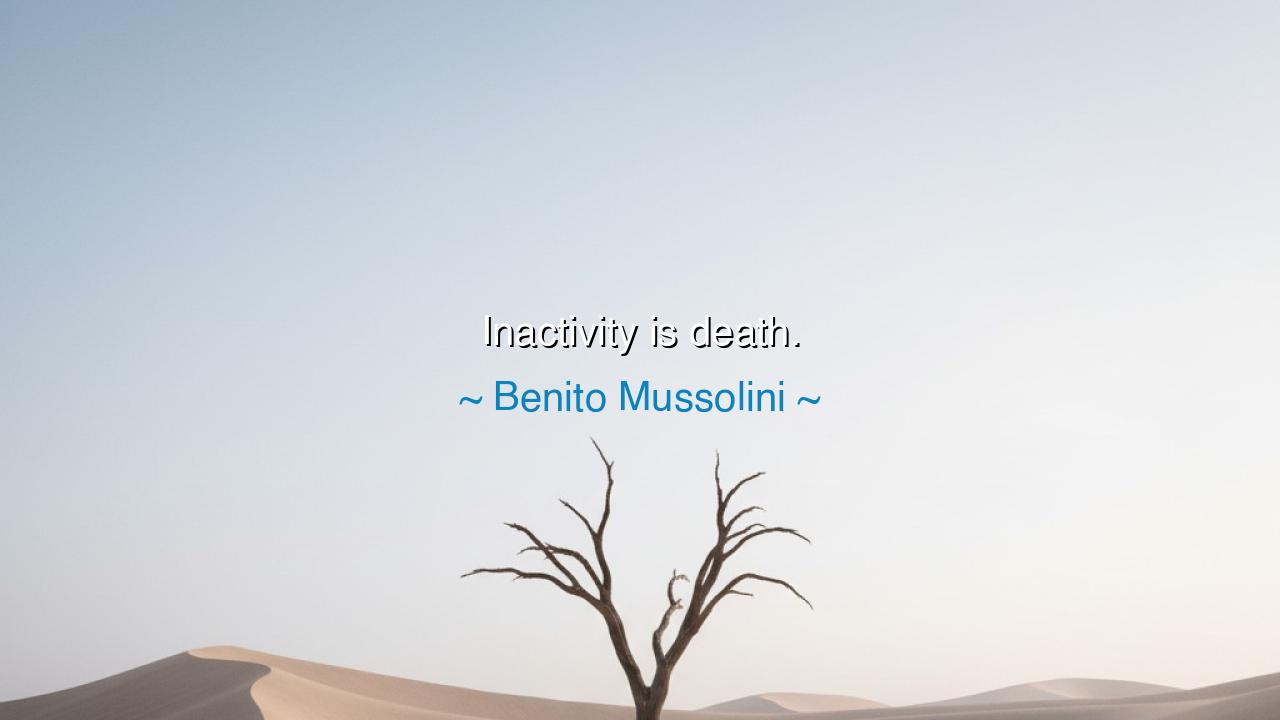
Inactivity is death.






“Inactivity is death.” – Benito Mussolini
There are words that strike the soul like the clang of a hammer upon an anvil—words that awaken the sleeping spirit and call it to motion. “Inactivity is death,” declared Benito Mussolini, a man whose fire of conviction, though later darkened by tyranny, captured a truth older than empires: that life itself is motion, that to cease striving is to perish. The saying transcends its speaker, for its wisdom belongs not to one man, but to the essence of existence. From the dawn of time, the universe has taught this lesson—the stars move, the rivers flow, the heart beats. Only what is lifeless stands still.
To understand this truth, we must strip it from its historical armor and gaze upon it as a principle of the soul. Inactivity, in its deepest sense, is not mere rest, but stagnation—the decay that comes when one ceases to grow, to act, to believe. A body that no longer moves weakens and dies; a mind that no longer questions becomes dull and blind; a nation that no longer strives toward virtue collapses beneath its own weight. Thus, death is not only the end of breathing—it is the surrender of purpose, the silence of will. The living must act, must create, must strive, for motion is the law of all that endures.
Consider the story of Leonardo da Vinci, that restless titan of the Renaissance. He was painter, sculptor, engineer, philosopher—never content, never still. His notebooks overflowed with sketches of machines, visions of flight, and studies of the human soul. Had he remained idle, had he waited for certainty before acting, the world would never have known the Mona Lisa, nor the bridges of his design, nor the very spirit of invention he awakened in humankind. His life proves that motion is creation, and that in every field of human effort, the hand that acts breathes life into the universe itself.
Even in nature, this law is written upon every leaf and wave. The ocean teems with life because it moves; the air gives breath because it stirs; the earth bears fruit because it changes with the seasons. But a pond left still becomes fetid, and a field left fallow grows barren. So too with the soul of man—when he ceases to act, his virtues rot into vices. Courage turns to cowardice, wisdom to vanity, faith to apathy. The moment we stop reaching forward, we begin to fall backward, for in the grand rhythm of life, motion is existence and stagnation is decline.
Yet we must understand this teaching with discernment. To say “inactivity is death” does not mean that rest is evil—for rest is the renewal of strength. But true rest serves action, just as night gives birth to dawn. The danger lies not in the pause between efforts, but in the abandonment of effort altogether. The wise man rests as a warrior sharpens his blade—not to flee the battle, but to return stronger. Thus, even in stillness, his spirit moves. His purpose remains alive, his heart awake.
O children of time, take heed: the world belongs not to those who merely dream, but to those who act. Let not your talents lie buried in the soil of hesitation. The artist who never paints, the thinker who never speaks, the lover who never dares—all are as lifeless as statues. Do not wait for the perfect moment, for perfection is born only through striving. Act, even in uncertainty. Move, even in fear. For every step, however small, keeps the flame within you from dimming.
The lesson is eternal: motion is the heartbeat of being. To live is to create, to seek, to risk. When you find yourself weary or doubtful, remember that inactivity is not safety—it is slow decay. Feed your soul with purpose, your mind with curiosity, your body with labor. Walk forward, even if the path is shrouded in mist. For as long as you move, you live; and as long as you live with purpose, you defy the darkness of death.






AAdministratorAdministrator
Welcome, honored guests. Please leave a comment, we will respond soon